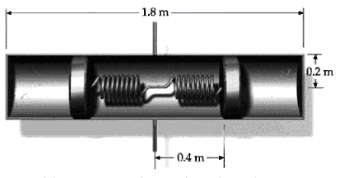Figure shows a hollow cylinder of length 1.8 m, mass 0.8 kg, and radius 0.2 m that
Question:
Figure shows a hollow cylinder of length 1.8 m, mass 0.8 kg, and radius 0.2 m that is free to rotate about a vertical axis through its center and perpendicular to the cylinder's axis. Inside the cylinder are two thin disks of 0.2 kg each, attached to springs of spring constant k and unstretched lengths 0.4 m. The system is brought to a rotational speed of 8 rad/s with the springs clamped so they do not stretch. The springs are then suddenly unclamped. When the disks have stopped their radial motion due to friction between the disks and the wall, they come to rest 0.6 m from the central axis. What is the angular velocity of the cylinder when the disks have stopped their radial motion? How much energy was dissipated in friction between the disks and cylinderwall?

Step by Step Answer:

Fundamentals of Ethics for Scientists and Engineers
ISBN: 978-0195134889
1st Edition
Authors: Edmund G. Seebauer, Robert L. Barry





